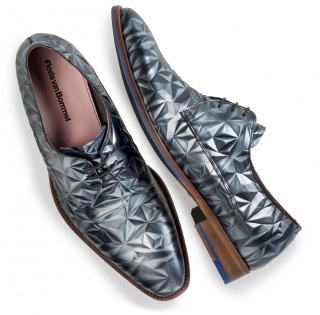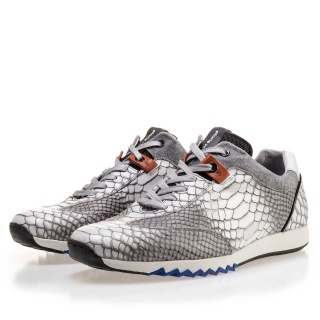Photography Sem Shayne



1734 – 2034
‘In 1734, everything was hand-made. By 2034, 3D printing may very well have obliterated our entire manufacturing industry, as everyone will have a printer at home to produce the goods they need. Of course, there is no synthetic material that even approaches calfskin, but I can imagine an even better material being developed in the future. People will burst out laughing when they hear that we used to make shoes from cowhide! Personally, I don’t eat any meat, but I console myself with the idea that leather is a waste product: cows are not slaughtered for their skin. We run our business responsibly but prefer not to express this actively in our marketing.’

300 designs per season – one design classic
‘Leading brands all have a ‘signature’: the typical Timberland, Ugg, or Converse. We don’t. I actually wonder if there will ever be a ‘typical Floris van Bommel’. It is our broad product line that is our ‘signature’. And this is an advantage. If the classic Timberland is ‘hot’ in 2019, sales will be on the rise, but in 2020 it may not be as popular. We don’t experience peaks like this. We design 75 models a season, and every model comes in four colours. All in all, those are 300 ‘positions’, and that’s quite a lot! Of course, they have to be finished at some point. Sometimes, one may sell very well, while you think ‘actually, this was a flop’. But people seem to like it. There is always some sort of coincidence.’

Understanding your target audience – 300 years of experience
‘Three hundred years of experience is important, but my assignment in 1999 was: “Just do whatever you like!” I was keeping close watch on all collection developments, so I was fully in tune with our brand’s rhythm and way of thinking. We combine a new sole with an interesting colour, or a fun print with another detail. The choices we make are totally subjective: you can imagine which target audience will appeal to a certain shoe, but we never really conduct any studies into this.’
Germany – world fame
‘Everything starts with attention. Our shoes are sold all over the world: China, Japan, New York, Australia. Still, you won’t get very far if you can’t pay enough attention. At present, we’re focusing entirely on the German market. Pepijn (commercial director, ed.) knows not only the director of the distributors, but also the purchaser and the head of marketing. Only if you organize things carefully will you be able to grow exponentially. A prime example of this is our ladies’ collection. Until now, we have produced this in Portugal. But Portugal isn’t known for its sophisticated sandals. For this, you need to go to Spain. The problem is that we don’t have such an extensive network in Spain, with suppliers and distributors, like we do in Portugal. So we’re going to get the ball rolling in Spain.’
Red Dot Design Award – EFFIE
‘Before we start off, you should know that I’m not a real designer. I’m much more interested in the story behind something. Last year, we engaged a special head of design for the men’s collection. When he sees a shoe from the 1990s, he immediately knows the year, brand, and production line. We talk a lot about shoes, and I’ve come to notice that my interest in the background story is growing, while he’s purely interested in the sole, stitching, and materials. Perhaps I’d rather win an EFFIE than a Design Award, although winning prizes isn’t that important to me.’
Niche – mainstream
‘I really enjoy music by Robert Flynn, lead singer and guitarist of the heavy metal band Machinehead. Although the band is world-famous, they’re still genuine people on stage. This inspires me. If someone takes an in-depth interest in what they do, you’ll recognize this in their performance. A great deal of thought has to go into everything that leaves our premises. In other words, I’d rather receive a Christmas card with crazy curlicues than some stupid stock photo. I want everything we do here to be of added value. I’d want the person receiving it to think about it longer than another person’s product. Otherwise, it’s a waste of energy.’

can’t be replicated by any robot.’

Signature – freedom
‘The only assignment I was ever given was by my father: ‘Just start’. I always start on a white piece of paper, without guidelines. If there is anything like a signature at all, it’s precisely this ‘freedom and variation’. My brother recently said: ‘Our marketing policy is actually inside your head!’ Still, someone needs to be able to replace my brothers and me some day. A new head of design forces me to put certain things on paper. If I were to have a car accident tomorrow, the repercussions would go further than the line we have charted out.
Traditional craftsmanship – digitalization
‘You have to know what you are doing. Our factory is located just five metres away. Everyone who comes to work here has to learn to make shoes first – even an administrative assistant. Every figure is a pair of shoes that has undergone a great deal of work.
You choose a design and a type of leather and take a look at all the machines. The more difficult work is done by our more experienced employees, because not everyone is capable of stitching a straight line. Lasting*, for example, takes a great deal of skill. But everyone can apply stain to the side of the sole. What our people make can’t be replicated by any robot.
I believe that robotization only contributes to mass production. An online design tool, like that of Nike, gives you the impression that you’re designing, but all those colour fields, soles, rings, and shoe laces won’t make your shoe any more attractive! 3D printing, however, can disrupt the entire clothing industry. Being able to print your shoes and jumpers at home is a revolution of far greater significance than the steam engine! I have no idea how our shoe factory will be able to survive in the future. Still, strong brands will always continue to exist. We are, after all, a family-run company and not a hollow label, like Camel shoes. We think in generations, not quarters. We don’t talk in euros, but in pairs of shoes. Today, we’re still the only bespoke shoe factory in the Netherlands. We owe all these things to my grandfather’s vision: ‘We make only good shoes and will not cut costs to do so.’
* Lasting = the operation that stretches the shoe upper over the foot form or last.

Sophisticated ladies’ shoes.



